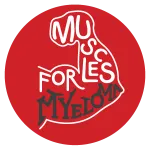Muscles for Myeloma: Don Wright is Onto Something

 Join us for Muscles for Myeloma in April by registering here.
Join us for Muscles for Myeloma in April by registering here.BY DANNY PARKER Don Wright is on to something. If you have been reading the preceding columns you’re likely seeing that there is strong evidence that exercise can help multiple myeloma patients. Moreover, it’s nearly certain that to enjoy the benefits even if you don’t run marathons. Over recent months I have waited a while to accumulate information for this column and not being a physical therapist, I have taken care to have the information reviewed. And while exercise can help, it is very important that I place some cautionary warnings up front. With multiple myeloma, our bones are often damaged. Accordingly, it is vitally important to consider each patient’s physical condition so that exercise is done safely and cautiously and in full consultation with your doctor. So talk to your doctor before you begin an exercise program. Your doctor can consider your body’s condition, blood counts, side effects of medicines and help to select routines that will be most safe for you. The ways in which exercise can help are numerous. Activity can help maintain or extend your range of motion in your joints and muscles. Properly done, it can also help with your energy level, reduce lethargy and fatigue and cultivate an appetite. Perhaps most importantly, exercise can help to reduce stress, anxiety and even depression. Exercise can help you to enjoy your life. As with individuals with osteoporosis, certain exercises may also help strengthen muscles, bones and ligaments. The level of exercise for you strongly depends on your current condition and ongoing treatment. When receiving active treatment for the disease, it is important not to do vigorous or harsh exercise regimes as the cancer is active in bones and affected limbs may be very vulnerable to fractures. Those receiving radiation or chemotherapy and are already on an exercise program may need to throttle it back and practice at a somewhat slower place. However, an important objective should be to maintain range of motion and activity as much as possible. For patients who had limited activity before diagnosis, lower intensity routines such as easy gentle yoga, short distance neighborhood walks and similar activities should be begun and only slowly increased. Let’s face it, many of us are older. There are special considerations if you are older, with bone disease or special issues such as arthritis or neuropathy. In particular, balance and balance training should be emphasized to reduce the risk for falls. It is important to discuss with your doctor about regions of bone damage in your own body so that any routine is approved or modified to protect delicate bones. One idea is to have your physical therapist contact your doctor. Your doctor can inform them of your health conditions and of any safety measures needed. Many insurance plans cover the cost of a physical therapist in a hospital. But you may need to pay out-of-pocket for outpatient services or home visits. Check with your insurance policy about coverage for physical therapy. Insurance does not usually cover the cost of personal fitness trainers. However, a few initial visits with a qualified personal trainer may be enough to get you started safely and may be money well spent. Once you have completed treatment for myeloma, your goals might be to regain bone and muscle strength, and, as much as possible, to return to normal daily physical activities. Added strength and a feeling vibrancy can help to improve your outlook and quality of life. don on patient power
Don Wright, Myeloma's Running Man from Patient Power on Vimeo.Thanks to our Muscles for Myeloma sponsors:


 Join us for Muscles for Myeloma in April by registering here.
Join us for Muscles for Myeloma in April by registering here.BY DANNY PARKER Don Wright is on to something. If you have been reading the preceding columns you’re likely seeing that there is strong evidence that exercise can help multiple myeloma patients. Moreover, it’s nearly certain that to enjoy the benefits even if you don’t run marathons. Over recent months I have waited a while to accumulate information for this column and not being a physical therapist, I have taken care to have the information reviewed. And while exercise can help, it is very important that I place some cautionary warnings up front. With multiple myeloma, our bones are often damaged. Accordingly, it is vitally important to consider each patient’s physical condition so that exercise is done safely and cautiously and in full consultation with your doctor. So talk to your doctor before you begin an exercise program. Your doctor can consider your body’s condition, blood counts, side effects of medicines and help to select routines that will be most safe for you. The ways in which exercise can help are numerous. Activity can help maintain or extend your range of motion in your joints and muscles. Properly done, it can also help with your energy level, reduce lethargy and fatigue and cultivate an appetite. Perhaps most importantly, exercise can help to reduce stress, anxiety and even depression. Exercise can help you to enjoy your life. As with individuals with osteoporosis, certain exercises may also help strengthen muscles, bones and ligaments. The level of exercise for you strongly depends on your current condition and ongoing treatment. When receiving active treatment for the disease, it is important not to do vigorous or harsh exercise regimes as the cancer is active in bones and affected limbs may be very vulnerable to fractures. Those receiving radiation or chemotherapy and are already on an exercise program may need to throttle it back and practice at a somewhat slower place. However, an important objective should be to maintain range of motion and activity as much as possible. For patients who had limited activity before diagnosis, lower intensity routines such as easy gentle yoga, short distance neighborhood walks and similar activities should be begun and only slowly increased. Let’s face it, many of us are older. There are special considerations if you are older, with bone disease or special issues such as arthritis or neuropathy. In particular, balance and balance training should be emphasized to reduce the risk for falls. It is important to discuss with your doctor about regions of bone damage in your own body so that any routine is approved or modified to protect delicate bones. One idea is to have your physical therapist contact your doctor. Your doctor can inform them of your health conditions and of any safety measures needed. Many insurance plans cover the cost of a physical therapist in a hospital. But you may need to pay out-of-pocket for outpatient services or home visits. Check with your insurance policy about coverage for physical therapy. Insurance does not usually cover the cost of personal fitness trainers. However, a few initial visits with a qualified personal trainer may be enough to get you started safely and may be money well spent. Once you have completed treatment for myeloma, your goals might be to regain bone and muscle strength, and, as much as possible, to return to normal daily physical activities. Added strength and a feeling vibrancy can help to improve your outlook and quality of life. don on patient power
Don Wright, Myeloma's Running Man from Patient Power on Vimeo.Thanks to our Muscles for Myeloma sponsors:


about the author
Jennifer Ahlstrom
Myeloma survivor, patient advocate, wife, mom of 6. Believer that patients can contribute to cures by joining HealthTree Cure Hub and joining clinical research. Founder and CEO of HealthTree Foundation.
More on Navigating Your Health
Trending Articles
Upcoming Events




Get the Latest Multiple Myeloma Updates, Delivered to You.
By subscribing to the HealthTree newsletter, you'll receive the latest research, treatment updates, and expert insights to help you navigate your health.











